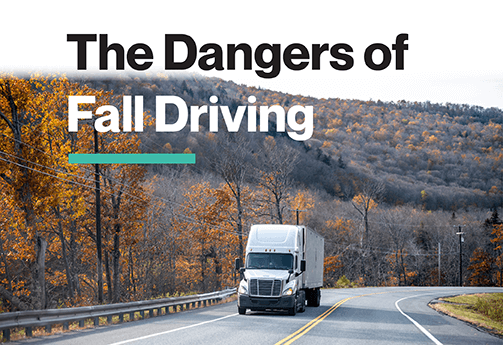The dangers of fall driving

As your fleet makes its way across the U.S., make sure your drivers are aware of – and prepared for – the dangers of fall driving.
Below are some of the unique challenges that come with autumn driving, as well as a few ways you can keep your fleet safe.
Danger #1: Wet Leaves
The vibrant colors of changing leaves may look beautiful, but they can pose a serious risk. While dry leaves on the road can reduce traction, but wet leaves are especially dangerous as they increase the risk of hydroplaning.
Safety Tips:
- Slow down!
- Avoid sudden braking and swerving.
- Increase your following distance.
- Be especially careful when turning.
- Never, ever drive over or through a pile of leaves as they may be hiding debris or potholes. They’re also a great place for children to hide, so pay particular attention in residential areas.
Danger #2: Deer
There are more deer-related vehicle accidents in the fall than at any other time of year. As it’s mating season, deer are more active between October and December with November being the most dangerous month.
Safety Tips:
- Avoid driving beyond the reach of your headlights.
- Pay attention to deer crossing signs and check both sides of the road when driving in wildlife areas.
- Reduce your speed at dawn and dusk as these are the times when deer are most active.
- Remember that deer travel in herds – when you see one there are likely others nearby.
- Don’t veer if a deer crosses the path of your truck; brake firmly and try to stay in your lane.
Danger #3: Sun Glare
Although it sounds a bit strange, sun glare is actually worse in the fall. The sun is moving closer to the horizon and getting lower in the sky, making it more difficult to see.
Safety Tips:
- Wear polarized sunglasses to protect your eyes and help manage the glare.
- Keep your windshield free of dirt, dust, streaks and scratches – both inside and out.
- Use your sun visor.
- Avoid washing and waxing products that increase the shine on your truck. These products can magnify the glare and cause it to reflect into your eyes.
- Sun glare is worse in early morning and late afternoon, so try to avoid driving at those times if possible.
Danger #4: Fog and Icing
The cool fall mornings may be a relief after a long, hot summer, but the lower temperatures can often mean fog. While fog can hamper visibility, it can also lead to icing if it drifts down over roads that have cooled below freezing temperatures. In this scenario, thicks coats of ice can form in just a few minutes.
Safety Tips:
- Set your headlights to low in foggy weather. High-beam headlights bounce off fog and reflect back at you, further impairing your ability to see the road.
- Reduce your speed and leave plenty of following distance.
- Be especially alert in the early mornings and during the night when temperatures are at their lowest. This is when you are most likely to encounter black ice.


